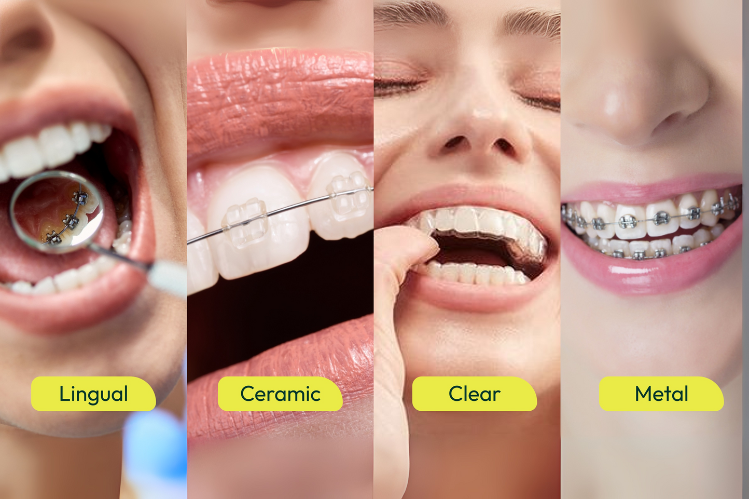
Tabla de contenido
- Brackets metálicos tradicionales: el clásico caballo de batalla
- Brackets de cerámica: más transparentes pero más costosos
- Brackets linguales: ocultos, pero de alto mantenimiento
- Alineadores transparentes: la opción moderna para usar en casa
- Brackets autoligables: elegantes, inteligentes y más rápidos
- ¿Cuáles son los mejores aparatos ortopédicos para usted?
- ¿Qué tipo de aparato es adecuado para usted?
- Preguntas frecuentes
¿Quieres enderezar tus dientes pero te sientes abrumado por todas las opciones disponibles? No estás solo. Si te lo preguntas, ¿Pueden los brackets arreglar los dientes torcidos ? Sí, pero elegir los mejores brackets no es solo... No se trata de lo que funciona, sino de lo que se adapta a tu vida y a tu presupuesto. Ya seas un adolescente activo, un padre ocupado o un... Si eres un adulto que trabaja y no quiere que se vean los brackets metálicos en las reuniones, existe una solución que puede funcionar. tú.
En esta guía, le explicaremos los 5 tipos principales de aparatos ortopédicos, para quiénes son mejores y cuánto puede esperar pagar. para que puedas elegir con confianza el ajuste correcto para tu sonrisa (y tu billetera).
Brackets metálicos tradicionales: el clásico caballo de batalla
Ideal para: niños, adolescentes y personas con necesidades de alineación complejas.
Presupuesto: $3,000–$7,000 (ortodoncista privado)
Los brackets metálicos son la joya de la corona de la ortodoncia. Son resistentes, fiables y eficaces para tratar todo tipo de afecciones, desde leves... El apiñamiento puede causar problemas graves de mordida. Claro, son visibles, pero los brackets metálicos actuales son mucho más elegantes y pequeños que... Solían serlo. Aunque el tiempo de tratamiento con aparatos tradicionales es más largo que el de los nuevos aparatos de ortodoncia. tratos.
Ventajas:
- Más eficaz para casos complicados.
- A menudo cubierto parcialmente por el seguro dental.
- Puedes elegir bandas de colores (divertido para niños y adolescentes)
Contras:
- Muy notable
- Viene con restricciones alimentarias y frecuentes ajustes en la oficina.
Entonces… ¿son los mejores brackets? Si necesitas una corrección seria y no te importa la apariencia, puede que lo sean.
Brackets de cerámica: más transparentes pero más costosos
Ideal para: adultos y adolescentes que desean algo menos visible que el metal.
Presupuesto: $4,000–$8,000
Los brackets de cerámica funcionan igual que los de metal, pero con brackets transparentes o del color del diente. Son populares entre las personas que... desea una opción más discreta pero aún necesita la resistencia de los aparatos fijos.
Ventajas:
- Menos visible que el metal
- Eficaz para casos moderados a complejos.
- Todavía ofrecen un movimiento dental preciso
Contras:
- Puede mancharse si no se cuida adecuadamente.
- Un poco más frágil que los brackets metálicos.
- Generalmente más caro
¿Qué es mejor, brackets metálicos o de cerámica? Depende de qué valores más: el presupuesto o la estética.

Brackets linguales: ocultos, pero de alto mantenimiento
Ideal para: adultos que desean una invisibilidad total y no les importa una curva de aprendizaje.
Presupuesto: $8,000–$10,000+
Los brackets linguales se colocan detrás de los dientes, así que nadie notará que los llevas puestos. ¡Suena perfecto! ¿Verdad? Bueno, casi.
Estos están hechos a medida y suelen ser utilizados por profesionales que aparecen en cámara o hablan en público. Pero pueden sentirse un poco... Al principio es un poco incómodo, lo que puede afectar el habla.
Ventajas:
- Totalmente invisible
- Ideal para entornos profesionales.
- Bueno para movimientos dentales complejos.
Contras:
- La opción más cara
- Puede causar irritación de la lengua.
- Más difícil de limpiar y ajustar
¿Son los brackets linguales los mejores para adultos? Si la invisibilidad es tu prioridad y el presupuesto no es un problema, entonces... Sí.

Alineadores transparentes: la opción moderna para usar en casa
Ideal para: adultos y adolescentes responsables con problemas de alineación leves a moderados.
Presupuesto: $1,000–$3,000 (en casa) o $4,000–$8,000 (en la clínica)
Los alineadores transparentes como los de ALIGNERCO han revolucionado el mundo. Son bandejas extraíbles de plástico transparente. Que gradualmente colocan tus dientes en su lugar. Sin alambres. Sin brackets. Sin momentos incómodos.
Y aquí está la mejor parte: con ALIGNERCO, puedes hacer todo el proceso desde casa, desde las impresiones hasta los retenedores. Es uno de los tratamientos de ortodoncia más asequibles disponibles, especialmente para quienes desean aparatos ortopédicos para una vida activa. estilo de vida.
Ventajas:
- Virtualmente invisible
- Extraíble para comer, cepillarse los dientes y usar hilo dental.
- Menos (o ninguna) visitas al dentista
- Cómodo y suave, sin cables que pinchen.
Contras:
- No apto para casos muy complejos
- Debes usarlos de 20 a 22 horas al día para ver resultados.
- La disciplina es clave
¿Buscas ortodoncia para un estilo de vida activo? Los alineadores son tu mejor aliado. Practica deportes, da presentaciones o participa. citas sin que nadie se dé cuenta.

Brackets autoligables: elegantes, inteligentes y más rápidos
Ideal para: personas que desean resultados más rápidos y menos citas.
Presupuesto: $3,500–$7,000
Los brackets autoligables tienen un aspecto similar a los brackets metálicos tradicionales, pero utilizan un sistema de clips especial en lugar de bandas elásticas. Esto significa menos visitas y tiempos de tratamiento potencialmente más rápidos.
Ventajas:
- Más fácil de limpiar que los aparatos ortopédicos convencionales
- Puede mover los dientes más rápido
- Menos ajustes en la oficina
Contras:
- Todavía visible
- No apto para todos los casos
- Los costos varían mucho dependiendo de la marca.
¿Qué tipo de ortodoncia funciona más rápido? Las opciones de autoligado suelen ganar esa carrera, pero solo si... El ortodoncista dice que eres un buen candidato.
¿Cuáles son los mejores aparatos ortopédicos para usted?
Aquí está la verdad: los “mejores brackets” no son los más caros ni los más invisibles, son los que se adaptan a tus necesidades. Estilo de vida. Antes de comprometerse con cualquier tratamiento de ortodoncia, considere los siguientes factores clave:
Tu rutina diaria
¿Estás siempre en movimiento? ¿Viajas con frecuencia? ¿Tienes un horario impredecible?
- Si es así, puede beneficiarse de opciones de bajo mantenimiento como alineadores transparentes que no requieren visitas frecuentes al consultorio.
- Por otro lado, si tienes una rutina estable y no te importan los controles periódicos, los brackets tradicionales o los de cerámica Los corchetes podrían funcionar bien.
Tus preferencias de apariencia
¿Qué importancia tiene que tus brackets sean discretos?
- Los adolescentes y los profesionales que trabajan a menudo prefieren alineadores o aparatos de cerámica que son menos notable.
- Si la visibilidad no te molesta y quieres la opción más rápida y económica, el metal Los aparatos ortopédicos podrían ser una gran opción.
Tiempo de tratamiento
¿Necesita resultados rápidos o prefiere un proceso más largo y gradual?
- Los brackets metálicos fijos suelen ofrecer resultados más rápidos, especialmente en casos complejos.
- Los alineadores transparentes pueden tardar un poco más, pero ofrecen una experiencia más flexible y cómoda.
Presupuesto y asequibilidad
¿Cuánto puedes invertir realistamente en tu sonrisa?
- Los aparatos metálicos tradicionales suelen ser la opción más económica en la clínica.
- Los alineadores transparentes de marcas para el hogar como ALIGNERCO son cada vez más populares debido a su asequibilidad y planes de pago flexibles, sin comprometer la calidad.
Nivel de compromiso
¿Eres lo suficientemente disciplinado para usar alineadores durante 20 a 22 horas al día?
- Los alineadores transparentes podrían ser tu combinación perfecta.
- Si es probable que olvide o se los quite con frecuencia, los aparatos fijos pueden ser una opción más segura para asegurarse de que no se los quite. Resultados consistentes.
Si está buscando una opción asequible, de bajo mantenimiento y discreta, los alineadores transparentes de ALIGNERCO pueden ser su solución. ser exactamente lo que necesitas. Sin visitas al dentista, sin cargos ocultos, solo un camino más fácil hacia una sonrisa más recta, desde el comodidad del hogar.
¿Qué tipo de aparato es adecuado para usted?
Los mejores aparatos para enderezar los dientes dependen de algo más que la apariencia ; se trata de lo que funciona para usted. Estilo de vida, presupuesto y comodidad. Los brackets metálicos tradicionales siguen siendo una de las opciones más efectivas y asequibles. Especialmente si la visibilidad no es una preocupación.
Los brackets cerámicos ofrecen una apariencia más sutil, pero pueden requerir un cuidado especial y un costo ligeramente mayor. Brackets linguales. están ocultos detrás de los dientes, haciéndolos casi invisibles, pero también son más caros y más difíciles de mantener.
Los brackets autoligables minimizan la fricción y reducen el tiempo de la cita, aunque pueden ser más caros. También existen opciones claras. alineadores, como ALIGNERCO, diseñados para adultos que desean una solución discreta, removible y de bajo mantenimiento sin visitas regulares a la clínica.
La forma más inteligente de enderezar tus dientes es elegir un tratamiento que se adapte a tu vida diaria. Ya sea Ya sea que optes por brackets clásicos o un elegante plan de alineadores transparentes para usar en casa, la mejor decisión es la que te ayuda a sentirte Con confianza en cada paso del camino. Y a veces, ese viaje puede comenzar con algo tan simple como pedir un... Kit de impresión en línea.
Preguntas frecuentes
1. ¿Qué marca es mejor para los brackets?
Eso depende de lo que busques. Por comodidad y asequibilidad, ALIGNERCO es... Una excelente opción para alineadores caseros. Para casos complejos, su ortodoncista podría sugerirle marcas disponibles en la clínica.
2. ¿Qué tipo de aparatos funcionan más rápido?
Los aparatos autoligables y, en algunos casos, los alineadores transparentes (si se usan correctamente) pueden ofrecer Resultados más rápidos que los tradicionales.
3. ¿Qué son mejores, los brackets metálicos o los de cerámica?
El metal es más duradero y económico; la cerámica es más discreta pero más costosa.
4. ¿Cuáles son los tipos de brackets más fuertes?
Los brackets metálicos son los más fuertes y efectivos para correcciones complejas.
Citas:
Ehsani, S., Mandich, MA, El-Bialy, T. y Flores-Mir, C. (2009). Comparación de la eficiencia de los brackets autoligables. Brackets convencionales durante el tratamiento de ortodoncia: una revisión sistemática. Revista Europea de Ortodoncia, 31(6), 645–654. https://doi.org/10.1093/ejo/cjp102
Watson, K. (14 de enero de 2019). Cómo la ortodoncia endereza los dientes en niños y adultos. Healthline. https://www.healthline.com/health/how-do-braces-work? #tipos-de-braces


 alt="¿Cuánto tiempo tardan en hacer efecto los brackets?" width="150" height="100" loading="lazy">
alt="¿Cuánto tiempo tardan en hacer efecto los brackets?" width="150" height="100" loading="lazy">
 alt="Mujer con alineadores transparentes para una sonrisa recta" width="150" height="100" loading="lazy">
alt="Mujer con alineadores transparentes para una sonrisa recta" width="150" height="100" loading="lazy">
 alt="Imagen comparativa de diferentes tipos de aparatos ortopédicos" width="150" height="100" loading="lazy">
alt="Imagen comparativa de diferentes tipos de aparatos ortopédicos" width="150" height="100" loading="lazy">


